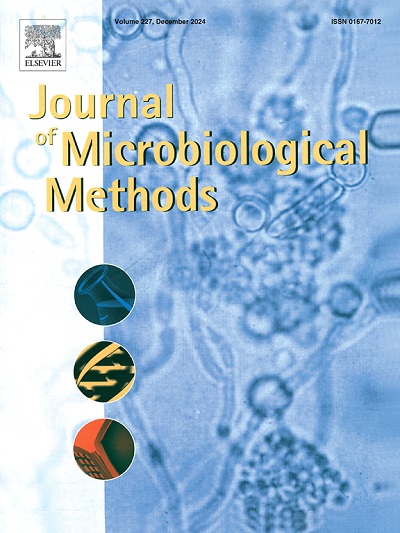银在新型合成培养基中对铜绿假单胞菌的抑制作用:MIC、生长速率和下限滞后期的研究
IF 1.9
4区 生物学
Q4 BIOCHEMICAL RESEARCH METHODS
引用次数: 0
摘要
银的抗菌性能是众所周知的,并得到了广泛的应用。虽然已知银与蛋白质等复杂有机物质相互作用和结合,但仍有许多在复杂培养基中进行的灭菌效率和抑制性能的实验。鉴于银通常应用于没有或很少有有机基质的环境中,如冷却回路或自来水和工艺用水的处理,因此对这些条件下的最低抑制浓度和致死浓度的进一步了解是有意义的。我们已经为标准细菌铜绿假单胞菌开发了一种确定的培养基,该培养基不含复杂的有机碳,具有与常用营养液相同的培养特性。利用这种培养基,我们可以将MIC的范围缩小到2.5 μg ~ 10 μg∙L−1,这与细菌细胞初始浓度的杀菌浓度有很大的重叠。这些结果可能有助于优化银的技术应用。我们进一步观察到,与无银对照相比,细菌培养物的生长延迟长达三天,这可能是由于部分灭菌导致理论上只有一个存活细胞,也可能是由于延迟期延长。根据这些观察结果,我们建议延长用银进行灭菌实验的孵育时间,并使用不与消毒剂相互作用的特定培养基。本文章由计算机程序翻译,如有差异,请以英文原文为准。

Inhibition of Pseudomonas aeruginosa with silver in a new synthetic medium: Investigation on the MIC, growth rate and lag-phase at the lower limit
The antimicrobial properties of silver are well-known and widely applied. Although it is known, that silver interacts and binds on complex organic substances like proteins, many experiments on the sterilisation efficiency and inhibiting properties are still carried out in complex culture media. Given, that silver is often applied in environments with no or few organic substrates, like cooling circuits or in the treatment of tap and process water, further insight on the minimum inhibition concentration and lethal concentration at those conditions is of interest. We have developed a defined medium for the standard bacterium Pseudomonas aeruginosa that is free of complex organic carbon with equal cultivation properties like commonly used nutrient solutions. With this medium we could narrow the range of the MIC between 2.5 μg to 10 μg∙L−1, which very much overlaps with the bactericidic concentration depending on the initial concentration of bacteria cells. These results might help to optimise the technical application of silver. We further observed a delayed growth of bacterial cultures of up to three days compared to silver free controls, which is caused either by a partial sterilisation down to theoretical one surviving cell or by a prolonged lag phase. Based on these observations we recommend a prolonged incubation for experiments on sterilisation with silver and the use of defined media, which do not interact with the disinfecting agent.
求助全文
通过发布文献求助,成功后即可免费获取论文全文。
去求助
来源期刊

Journal of microbiological methods
生物-生化研究方法
CiteScore
4.30
自引率
4.50%
发文量
151
审稿时长
29 days
期刊介绍:
The Journal of Microbiological Methods publishes scholarly and original articles, notes and review articles. These articles must include novel and/or state-of-the-art methods, or significant improvements to existing methods. Novel and innovative applications of current methods that are validated and useful will also be published. JMM strives for scholarship, innovation and excellence. This demands scientific rigour, the best available methods and technologies, correctly replicated experiments/tests, the inclusion of proper controls, calibrations, and the correct statistical analysis. The presentation of the data must support the interpretation of the method/approach.
All aspects of microbiology are covered, except virology. These include agricultural microbiology, applied and environmental microbiology, bioassays, bioinformatics, biotechnology, biochemical microbiology, clinical microbiology, diagnostics, food monitoring and quality control microbiology, microbial genetics and genomics, geomicrobiology, microbiome methods regardless of habitat, high through-put sequencing methods and analysis, microbial pathogenesis and host responses, metabolomics, metagenomics, metaproteomics, microbial ecology and diversity, microbial physiology, microbial ultra-structure, microscopic and imaging methods, molecular microbiology, mycology, novel mathematical microbiology and modelling, parasitology, plant-microbe interactions, protein markers/profiles, proteomics, pyrosequencing, public health microbiology, radioisotopes applied to microbiology, robotics applied to microbiological methods,rumen microbiology, microbiological methods for space missions and extreme environments, sampling methods and samplers, soil and sediment microbiology, transcriptomics, veterinary microbiology, sero-diagnostics and typing/identification.
 求助内容:
求助内容: 应助结果提醒方式:
应助结果提醒方式:


